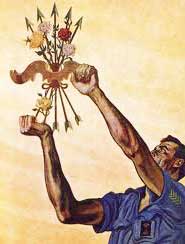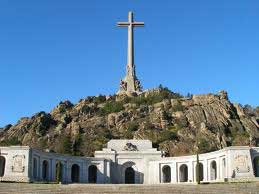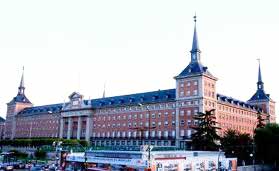Fascist Architecture

The years immediately following the official end of the Civil War and the triumph of the Falange in what was dubbed by them as a 'holy war' brought tremendous amounts of hardship, as General Francisco Franco consolidated his place at the top of the echelons of power with a policy that has widely been known as the 'repression'. It was the establishment of Fascism as the ruling philosophy in Spain.
During the 1940s and well into the first half of the 1950s, life in Spain was dominated by an extension of the Civil War, which was no longer waged on the battle fields but remained very much active on the political front. Consequently, the development of a cultural environment was largely restricted to underground activities or government-endorsed expressions, which often amounted to little more than propaganda.
Valle de los caídos

In terms of the architecture, Franco promoted the sort of monumental, heroic and deeply symbolic projects that previously had shaped the streets of Berlin and Munich or Rome and Milan. The first significant example of this kind of monuments is obviously the mausoleum known as the Valle de los caídos, a complex erected at the top of the Sierra de Guadarrama, in the vicinity from the Monastery of El Escorial, with an abbey and an enormous cemetery intended to serve as tribute to those fallen during the war.
The Valle de los caídos was designed by Pedro Muguruza and Diego Méndez, following the wishes of General Franco to create a monument that would defy the passage of time and that would inspire awe in visitors for all time. Colossal in size, the mausoleum's most distinctive symbol is a gigantic cross that presides over the abbey itself. Regardless of its ideological symbolism, this is a monument that you should not miss if you go one day to Madrid.
The End of the Repression
While the order to start the Valle de los caídos was given as soon as 1940, it was not finished until 1957. By this time the regime's repression had subsided and sufficient funds were found to promote other projects. For instance, there was the construction of the Arch of Victory right at the heart of Moncloa, a suburb of Madrid, where Franco would also order the construction of the Headquarters of the Air force.
The symbolism of the arch is evident, and the fact that it was erected in the mid-fifties, when the repression had completely stifled any efforts to resist also bears no small significance. Designed by Modesto López Otero and Pascual Bravo Sanfeliú it features the traditional semicircular arch with a wide lintel where an inscription dedicates the building to the victorious army. The whole is topped by an affecting sculpture of Victory in her Quadriga.
Right next to the Arch of Victory lies the Headquarters of the Air force. Given in commission to Luis Gutiérrez Soto, the design is almost an exact, if miniature, replica of Juan de Herrera's Monastery of El Escorial. Built between 1942 and 1951, this is a perfect example of Franco's idea of Fascism, not only in an aesthetic sense.

Enormous, imposing and, also, impressive, the Ministry of the Sky, as it was dubbed in Spanish (Ministerio del Aire) evidences Franco's obsession with the ideal of Imperial Spain, while at the same time it makes the connection with the monumentalism of totalitarian architectures, whether they are held by principles of constructivism or rationalism.
As the decade of the 1950s moved forward, however, the iron fist of Franco's Fascism was slowly loosened over a population that no longer held any hopes of putting an armed fight. It was not a case of coincidence that the cultural establishment in Spain, heavily thwarted by censorship and repression up to that point, saw a resurgence in all aspects, architecture included.
The final two decades of the dictatorship were also influenced by a growing interest from the side of the government to portray an image of progress and modernisation in the eyes of Europe and the United states. Consequently, efforts were made during international events, such as the world's fairs of 1958 and 1964 to built impressive pavilions that were not truly representative of the Spanish architectural landscape of the time.
